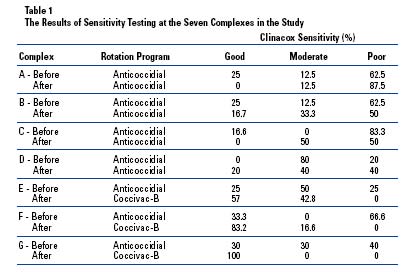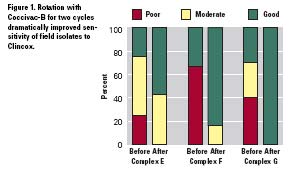COCCI R&D - Irrefutable Evidence
New study validates theory that vaccinating with Coccivac-B restores Eimeria sensitivity to diclazuril
 Dr. David Chapman
|
 Dr. Harry Danforth
|
Along-held theory that vaccinating
with Coccivac-B for just two
cycles restores Eimeria sensitivity
to the new-generation in-feed anticoccidial
diclazuril (Clinacox) was validated
recently in a large-scale field trial
with a major US poultry company.
The results, according to poultry
disease specialists involved in the
study, could change the broiler industry's
strategy for managing coccidiosis,
a costly parasitic disease in poultry.
Previous investigations into
the relationship between
coccidiosis vaccination and
in-feed anticoccidials -
including studies by wellknown
researchers Dr. David
Chapman of the University of
Arkansas, Dr. Harry Danforth,
USDA, and Dr. Greg Mathis of
Southern Poultry Research in
Athens, Georgia. "have
demonstrated that vaccinating
with Coccivac-B restores anticoccidial
sensitivity in a poultry
house by replacing resistant
Eimeria organisms with
ones still sensitive to in-feed
anticoccidials used today.
"In addition, pen trials
over the years have indicated
that Coccivac-B used in a
rotational program can effectively
displace wild field
strains of coccidia and restore
sensitivity to the current infeed
anticoccidials," says Dr.
Rick Phillips, director of
worldwide poultry technical
services, Schering-Plough
Animal Health.
"Those studies, however,
focused on ionophore anticoccidials,
not on diclazuril, now a widely-used,
chemical anticoccidial.
Despite the research and all the
field reports in hand, we felt it was
important to test our hypothesis in the
field where the proverbial 'rubber
meets the road'," Phillips says. "These
latest trials with diclazuril without a
doubt prove our hypothesis."
Study background and design
The study, sponsored by Schering-
Plough Animal Health, was conducted
at the site of a large US integrator.
Independent investigators involved in
the trial were the poultry company's
veterinarian and Dr. Mathis of Southern
Poultry Research, who conducted sensitivity
testing.
The integrator, which asked not to
be identified in this report, added
Coccivac-B to its anticoccidial rotation
to see if using the live-oocyst vaccine
improved the effectiveness of diclazuril
"or changed the coccidial population
to one more sensitive to diclazuril "as
well as conventional ionophores. The
move was part of a concerted effort by
the company to develop new tools and
long-term strategies for managing coccidiosis.
The poultry company first collected
litter samples from eight farms involved
with its seven complexes to obtain
baseline diclazuril sensitivity information.
Prior to this, the complexes had
been on a variety of in-feed anticoccidial
rotation programs, all of
which included diclazuril for one to
two cycles the previous year, he says.
Dr. Charlie Broussard, worldwide
poultry technical services manager
for Schering-Plough Animal Health,explains that after collecting initial litter
samples, four of the seven complexes
continued their annual rotation using
ionophores or chemical-ionophore
shuttle programs. The remaining three
complexes incorporated two cycles of
Coccivac-B vaccine into the annual
rotation. Identical houses were re-sampled
after two cycles of Coccivac-B or
anticoccidial rotation.
To determine diclazuril sensitivity,
Mathis looked at weight reduction and
coccidial lesion scores in test birds and
compared them to unchallenged controls.
He then summarized diclazuril's
efficacy as "good," "moderate" or
"poor."
"Even though diclazuril was given a
rest, diclazuril sensitivity did not
improve or improved very little in the
complexes that rotated diclazuril with
other in-feed anticoccidials, rather than
with the vaccine," Broussard says. "On
the other hand, diclazuril sensitivity
improved significantly in the complexes
that used two cycles of Coccivac-B
in the rotation. Not one of the samples
tested scored 'poor' for sensitivity following
Coccivac-B use." (See Figure 1.)
A few highlights from the trial follow,
according to Broussard:
"� In one complex, diclazuril sensitivity
before vaccination was rated "good" in
only 30% of samples. After vaccination,
however, 100% of samples were rated
"good."
"� In another complex, only 33% of
samples were rated good before vaccine
use, compared to 83% after vaccination.
(See Table 1.)
"� In contrast, one complex where the
vaccine was not used, investigators
rated only 25% of samples as "good"
for diclazuril sensitivity at the start of
the study. After continuing on a traditional
rotation program and "resting"
diclazuril, 0% of the samples were rated
"good" for diclazuril sensitivity.
Considering its 2-to 3-years' experience
with coccidiosis vaccination and
the results of this trial, the poultry company
plans to continue using Coccivac
and will carefully monitor results as
well as assess the vaccine's role in
long-term methodology. "Many other
factors are involved with the selection
process so we cannot say that the
process is sensitivity driven, though
that's a major factor," says a veterinarian
for the company.
 |
Take-home message
Pointing to the good performance of
the vaccinated flocks and the reduction
in lesion scores, investigator Mathis
notes that two cycles of Coccivac-B
prompted a dramatic shift toward
increased diclazuril sensitivity.
"We followed exactly the same
houses before and after diclazuril was
used, then used Coccivac so we could
pinpoint for sure whether we were
replacing resistance," he says. "The
results demonstrate that we can replace
or at the very least dilute the amount of
Eimeria resistance that's out there by
using Coccivac for several cycles and
making it part of a long-term control
program."
Mathis, who calls the landmark trial
"one of the most coccidiosis-significant
studies" he's worked on in more than
20 years, thinks the results will go a
long way toward directing coccidiosis
management in the future.
 |
"The take-home message is that to
get the performance you got when you
originally had diclazuril or other in-feed
anticoccidials, you're going to have to
use a vaccine. Coccivac is the only coccidiosis
vaccine that has clearly demonstrated
that it can replace resistance."
Phillips agrees and says the results
are almost an exact duplication of past
pen study trial results. "These are powerful
findings that could revolutionize
the way the industry controls coccidiosis
for years to come," he adds.
"For the first time in decades, vaccination
is being viewed as a foundation
to successful coccidiosis management
"one that can be used either yearround
or in a carefully planned, longterm
rotation with in-feed anticoccidials
to maximize their impact."
Source: CocciForum Issue No.7, Schering-Plough Animal Health.







